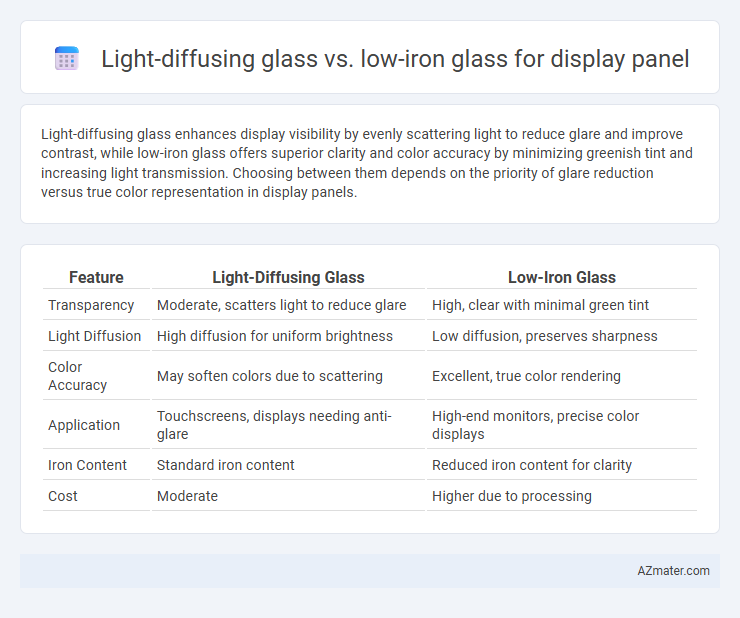Light-diffusing glass enhances display visibility by evenly scattering light to reduce glare and improve contrast, while low-iron glass offers superior clarity and color accuracy by minimizing greenish tint and increasing light transmission. Choosing between them depends on the priority of glare reduction versus true color representation in display panels.
Table of Comparison
| Feature | Light-Diffusing Glass | Low-Iron Glass |
|---|---|---|
| Transparency | Moderate, scatters light to reduce glare | High, clear with minimal green tint |
| Light Diffusion | High diffusion for uniform brightness | Low diffusion, preserves sharpness |
| Color Accuracy | May soften colors due to scattering | Excellent, true color rendering |
| Application | Touchscreens, displays needing anti-glare | High-end monitors, precise color displays |
| Iron Content | Standard iron content | Reduced iron content for clarity |
| Cost | Moderate | Higher due to processing |
Introduction to Display Panel Glass Technologies
Light-diffusing glass enhances display visibility by scattering incident light to reduce glare and improve image clarity, making it ideal for high-ambient-light environments. Low-iron glass offers superior transparency and color accuracy by minimizing iron oxide content, which reduces the green tint typical in regular glass, thus delivering truer colors and higher brightness in display panels. Both technologies optimize visual performance but cater to different needs: light diffusion for anti-glare properties and low-iron glass for maximum optical clarity and color fidelity.
What is Light-Diffusing Glass?
Light-diffusing glass is engineered to scatter light evenly across a display panel, reducing glare and hotspots to enhance visual clarity and viewing comfort. Unlike low-iron glass, which primarily offers higher transparency and reduced green tint for greater color fidelity, light-diffusing glass incorporates microscopic surface textures or embedded particles that diffuse incoming light. This technology is essential for displays in bright environments, improving readability by minimizing reflections without compromising brightness or color accuracy.
What is Low-Iron Glass?
Low-iron glass is a high-transparency glass type with reduced iron content, resulting in minimal green tint and enhanced light transmission compared to standard glass. This property makes it ideal for display panels requiring accurate color representation and high visibility. In contrast, light-diffusing glass scatters light to reduce glare but does not provide the same clarity and color fidelity essential for high-performance display applications.
Optical Clarity: Comparing Light-Diffusing and Low-Iron Glass
Light-diffusing glass scatters light to reduce glare and enhance visibility in bright environments, making it ideal for displays requiring uniform brightness without sharp reflections. Low-iron glass offers superior optical clarity due to its reduced iron content, minimizing the greenish tint typical in standard glass and providing more accurate color rendering and higher light transmission. For display panels demanding crisp images and color fidelity, low-iron glass outperforms light-diffusing glass by maintaining clarity while light-diffusing glass prioritizes glare reduction over optical sharpness.
Light Transmission and Diffusion Properties
Light-diffusing glass enhances display panel visibility by evenly scattering light, reducing glare and hotspots, which improves image clarity under various lighting conditions. Low-iron glass offers higher light transmission, typically above 90%, resulting in brighter, more vibrant displays with minimal color distortion. Choosing between these glasses depends on whether uniform light diffusion or maximum brightness and color accuracy is the priority for the display application.
Impact on Display Brightness and Color Accuracy
Light-diffusing glass enhances display brightness by evenly scattering light across the panel, reducing glare and minimizing hotspots, which improves visual comfort and uniformity. Low-iron glass, characterized by its higher clarity and reduced greenish tint due to minimal iron content, allows maximum light transmission, resulting in more vibrant colors and heightened color accuracy. When prioritizing both brightness and color fidelity in display panels, low-iron glass typically delivers superior color precision, while light-diffusing glass excels in mitigating reflection and enhancing perceived brightness.
Durability and Surface Resistance
Light-diffusing glass for display panels offers enhanced durability with its ability to evenly distribute light, reducing glare and minimizing surface scratches through specialized coatings. Low-iron glass provides superior surface resistance due to its high purity, which increases clarity and strength while resisting environmental wear and chemical damage. Both materials enhance display longevity, but low-iron glass typically excels in hardness and scratch resistance, making it ideal for more demanding applications.
Aesthetic and Design Considerations
Light-diffusing glass enhances display panel aesthetics by evenly scattering light to reduce glare and minimize hotspots, resulting in a smoother visual experience. Low-iron glass offers superior clarity and higher light transmission, preserving vibrant color accuracy and sharpness critical for premium design applications. Designers often prioritize light-diffusing glass for softened visuals and low-iron glass when maximum transparency and brightness are essential.
Cost and Manufacturing Implications
Light-diffusing glass incorporates microstructures or coatings that scatter light to reduce glare and improve visibility, typically increasing manufacturing complexity and cost due to additional processing steps and material treatments. Low-iron glass offers higher clarity and reduced green tint, requiring more refined raw materials and controlled production processes, which can raise costs but often remains more straightforward to produce than light-diffusing variants. Choosing between light-diffusing and low-iron glass for display panels depends on balancing the added expense of diffusion technology against the premium materials cost and clarity benefits of low-iron glass, impacting overall manufacturing budgets and supply chain sourcing.
Choosing the Right Glass for Your Display Panel
Light-diffusing glass enhances visibility by scattering light evenly, reducing glare and improving viewing angles, making it ideal for display panels in bright environments. Low-iron glass offers superior clarity and color accuracy by minimizing impurities and yellow tint, ensuring true-to-life image reproduction essential for high-end displays. Choosing between light-diffusing and low-iron glass depends on whether your priority is glare reduction or maximum clarity and color fidelity for your display panel.

Infographic: Light-diffusing glass vs Low-iron glass for Display panel
 azmater.com
azmater.com